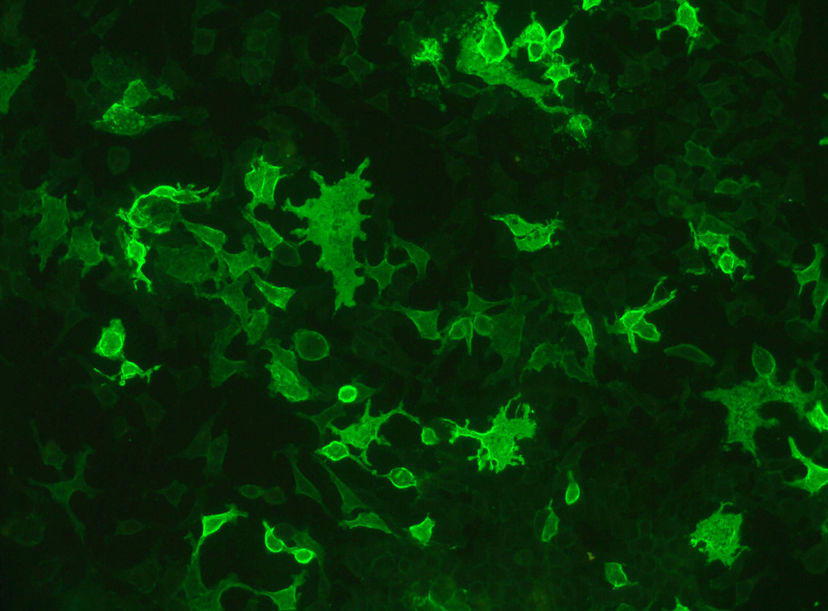Comprehensive autoantibody testing in neurological diseases
More than 60 neural autoantibodies can be determined using a unique portfolio of tests from Euroimmun, including many novel and exclusive parameters
5 Mar 2024

AQP-4 cell-based assay
Autoantibodies in neurological diseases are being identified at an unprecedented rate, leading to the recognition of many novel clinical syndromes. The diseases can manifest with an array of symptoms affecting the central, peripheral and autonomic nervous systems and may co-occur with malignancies. In unexplained neurological cases, a thorough autoantibody analysis can help to secure a diagnosis and guide decisions on immunotherapy and cancer screening.
Autoantibody testing is now a recommended diagnostic criterion for diseases such as autoimmune encephalitis, neuromyelitis optica spectrum disorders (NMOSD) and myasthenia gravis. Since many of the autoantibodies are rare and clinical symptoms may overlap, comprehensive multiparameter testing is paramount. The target antigens of neural autoantibodies encompass intracellular proteins, receptors and ion channels.
Range of target antigens
Classical neural autoantibodies are directed against intracellular antigens expressed in the cerebellum, like Hu, Yo, Ri, CV2, PNMA2, SOX1 and amphiphysin. These antibodies are considered non-pathogenic and are epiphenomena of tumour cells expressing neuronal antigens. The autoantibodies serve as important biomarkers for paraneoplastic neurological syndromes (PNS) and often provide the first indication of a tumour.
More recently identified autoantibodies target cell-surface antigens such as AQP4, NMDAR, LGI1, CASPR2, AMPAR1/2, GABAR, DPPX and IgLON5. These antibodies are pathogenic and frequently non-paraneoplastic. They cause inflammatory damage to the brain and nerves and can trigger seizures, impairment of vision, psychosis and/or movement disorders. In contrast to PNS, these disorders generally respond well to immunotherapy, but therapy must be started early to prevent irreversible neurological damage.
Pioneering IFA range
Indirect immunofluorescence assays (IFA) are an indispensable method for the detection of neural autoantibodies. Tissue sections of nerves, cerebellum, hippocampus and intestine enable comprehensive screening of autoantibodies against both known and unknown target antigens. For specific detection of defined autoantibodies, Euroimmun has developed IFA based on transfected human cells expressing the corresponding target antigen or epitopes thereof. This innovative technology is particularly suitable for neuronal cell-surface antigens, which are often conformation-dependent and fragile and thus unsuitable for the expression and purification procedures required for solid-phase methods such as ELISA or immunoblot. Further, as the antigens do not need to be obtained in purified form, the assays can be developed rapidly, enabling novel parameters to be incorporated promptly into the test repertoire.
Cell-based assays with CE mark are available for the detection of autoantibodies against NMDA receptors, AMPA 1/2 receptors. GABAB receptors, LGI1, CASPR2, DPPX, IgLon5, GAD65, Zic4, DNER/Tr, AQP4, MOG, AChR and MuSK. A large range of additional parameters is available for research use, including neurofascin 155, neurofascin 186, CASPR1, contactin-1, GABAA receptors, mGluR1, mGluR5, adenylate kinase 5 and flotillin-1/2.
Multiple antibodies can be easily investigated in parallel using BIOCHIP Mosaics composed of different tissue and cell substrates which are incubated simultaneously. Euroimmun offers a range of CE-marked IFA Mosaics tailored to different diagnostic applications, for example, autoimmune encephalitis, myasthenia gravis and NMOSD.
Multiplex immunoblots
Immunoblots are suitable for detection of antibodies against more stable antigens, including many intracellular antigens. With multiplex line blots, many different antibodies can be analysed in parallel. In blots of the EUROLINE range, the antigens are contained on individual membrane chips, allowing antigens with widely different properties to be combined in application-oriented profiles. The EUROLINE Paraneoplastic Neurologic Syndrome 12 Ag Profile includes the intracellular antigens amphiphysin, CV2, PNMA2 (Ma2/Ta), Ri, Yo, Hu, recoverin, SOX1, titin, Zic4, and GAD65 plus the receptor antigen DNER/Tr, enabling a broad analysis of autoantibodies associated with PNS. EUROLINE Ganglioside Profiles provide multiparameter detection of autoantibodies against gangliosides in polyneuropathies such as Guillain-Barré syndrome.
Automation solutions
Euroimmun offers a flexible range of automation solutions for neural autoantibody tests. These include the EUROLabWorkstation IFA for high-throughput processing at a capacity of 200 samples per hour, the EUROPattern Microscope series for fast fluorescence-image acquisition and on-screen evaluation, and the EUROPattern Classifier software for deep-learning-based evaluation of fluorescence patterns on cell-based substrates. The newly launched UNIQO 160 combines fully automated IFA processing and image acquisition in one device, with software-based evaluation to be incorporated soon. EUROLINE immunoblots can be processed fully automatically using the EUROBlotOne, which can process up to 44 test strips per run. The EUROLineScan software subsequently identifies and assigns the bands and generates patient reports.
Summary
- Euroimmun's neurobiomarker test portfolio encompasses more than 60 neural autoantibodies, including novel and exclusive parameters.
- Innovative cell-based assays and immunoblot technologies provide sensitive and specific antibody detection.
- Multiparameter formats enable comprehensive analyses.
- Flexible automation solutions increase standardization and efficiency.
More information on Euroimmun's research and product portfolio for autoimmune neurology can be found here.
